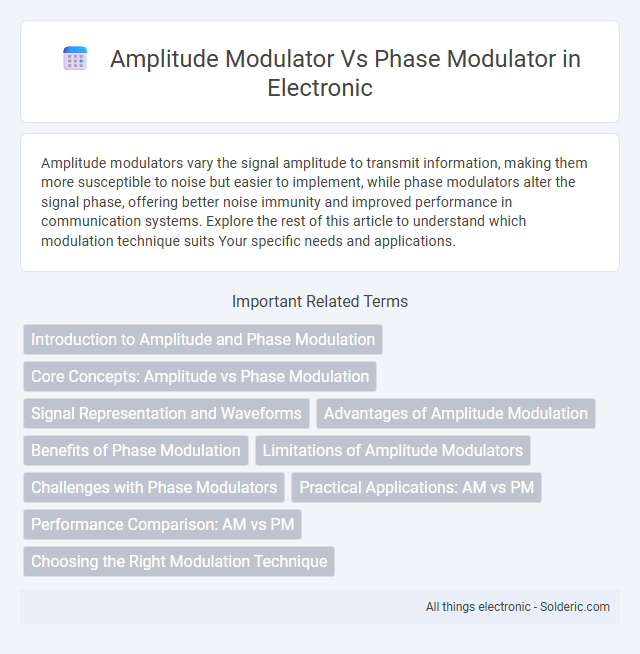Amplitude modulators vary the signal amplitude to transmit information, making them more susceptible to noise but easier to implement, while phase modulators alter the signal phase, offering better noise immunity and improved performance in communication systems. Explore the rest of this article to understand which modulation technique suits Your specific needs and applications.
Comparison Table
| Feature | Amplitude Modulator | Phase Modulator |
|---|---|---|
| Modulation Parameter | Amplitude of carrier wave | Phase of carrier wave |
| Primary Use | AM radio, broadcasting | PSK in digital communications |
| Signal Variation | Signal amplitude changes with message | Signal phase shifts with message signal |
| Noise Sensitivity | High, especially amplitude noise | Lower compared to AM |
| Bandwidth Efficiency | Less efficient | More efficient |
| Power Efficiency | Low, power varies with amplitude | High, constant amplitude carrier |
| Complexity | Simple transmitter and receiver | More complex receiver design |
| Applications | AM radio, TV audio | Bluetooth, Wi-Fi, digital modems |
Introduction to Amplitude and Phase Modulation
Amplitude modulation (AM) varies the signal's amplitude to encode information, while phase modulation (PM) changes the phase of the carrier wave to transmit data. These modulation techniques are fundamental in communication systems, with AM commonly used in radio broadcasting and PM employed in digital communication for better noise resistance. Your choice between amplitude and phase modulation depends on factors like signal clarity, bandwidth efficiency, and transmission environment.
Core Concepts: Amplitude vs Phase Modulation
Amplitude modulation (AM) varies the signal's amplitude to encode information, while maintaining a constant phase and frequency; in contrast, phase modulation (PM) alters the phase of the carrier wave to represent data without changing amplitude. AM signals are more susceptible to noise and signal fading due to amplitude variations, whereas PM offers better noise immunity by encoding information in the phase angle. Key applications of AM include traditional radio broadcasting, while PM is predominantly used in digital communication systems and advanced modulation schemes like phase-shift keying (PSK).
Signal Representation and Waveforms
Amplitude modulators vary the signal amplitude proportionally to the message signal, producing waveforms with changing envelope shapes while maintaining constant frequency and phase. Phase modulators adjust the instantaneous phase of the carrier signal according to the message signal, resulting in waveforms with constant amplitude but fluctuating phase shifts. Understanding these differences in signal representation and waveforms helps you choose the appropriate modulation technique for specific communication requirements.
Advantages of Amplitude Modulation
Amplitude modulation offers simplicity in implementation and requires less bandwidth compared to phase modulation, making it cost-effective for many communication systems. Its compatibility with existing AM receivers ensures broad accessibility and easier signal detection, particularly in broadcasting. You benefit from clearer signal transmission in cases where signal phase distortion might occur, giving amplitude modulation an advantage in reliable audio broadcasting.
Benefits of Phase Modulation
Phase modulation offers superior noise resistance and improved signal integrity compared to amplitude modulation, making it ideal for reliable communication in noisy environments. It provides reduced signal fading and better bandwidth efficiency, enhancing overall system performance. These advantages make phase modulation preferred in digital communication systems such as PSK (Phase Shift Keying).
Limitations of Amplitude Modulators
Amplitude modulators face limitations such as susceptibility to noise and signal fading due to amplitude variations, which can degrade signal quality. Their efficiency is lower compared to phase modulators because they consume more power and generate significant distortion at high modulation indices. You should consider phase modulators when robustness and spectral efficiency are critical for communication systems.
Challenges with Phase Modulators
Phase modulators face challenges such as increased sensitivity to noise and non-linear distortion, which can degrade signal quality in communication systems. Unlike amplitude modulators, phase modulators require more complex demodulation techniques and are more susceptible to phase jitter, making precise synchronization essential. Your system design must address these issues to ensure reliable data transmission and minimize error rates.
Practical Applications: AM vs PM
Amplitude modulators (AM) are widely used in broadcasting, such as AM radio transmissions, where signal robustness and simpler receiver design are critical. Phase modulators (PM) find practical applications in digital communication systems, including satellite and cellular networks, offering better noise immunity and efficient bandwidth usage. Your choice between AM and PM depends on the specific communication requirements, balancing factors like signal quality, complexity, and environmental resistance.
Performance Comparison: AM vs PM
Amplitude modulators vary the signal amplitude while preserving phase, resulting in susceptibility to noise and signal attenuation during transmission, which can degrade overall performance. Phase modulators encode information in the phase of the carrier wave, offering higher noise immunity and better spectral efficiency, making them more reliable in complex communication environments. In terms of bandwidth, PM generally requires more but provides superior distortion resistance compared to AM, which often experiences nonlinear distortion under high modulation indices.
Choosing the Right Modulation Technique
Choosing the right modulation technique depends on the application's requirements for bandwidth efficiency, noise immunity, and signal integrity. Amplitude modulation (AM) is simpler and suitable for broadcasting where bandwidth is ample, but it is more susceptible to noise and signal degradation. Phase modulation (PM) offers better noise resistance and spectral efficiency, making it ideal for digital communications and scenarios demanding higher signal fidelity.
Amplitude modulator vs phase modulator Infographic

 solderic.com
solderic.com